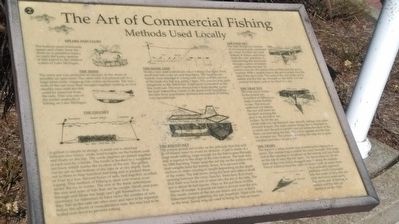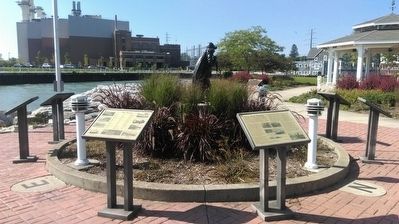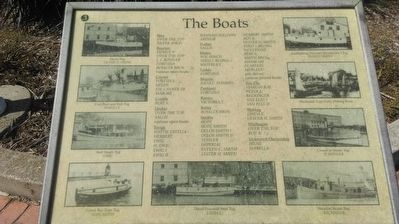Port Washington in Ozaukee County, Wisconsin — The American Midwest (Great Lakes)
The Art of Commercial Fishing
Methods Used Locally
Spears and Clubs
The Indians used handmade spears and clubs, from shore or in primitive boats, to catch the many species of fish native to the shallow waters of Lake Michigan.
The Seine
The seine net was anchored at one end, to the shore or possibly an open boat. The other end was played out in a large semi-circle, trapping fish within its bounds. The two ends of the net were then brought together creating an ever smaller area until the fish could be removed from the nets. This was one of the earlier methods of fishing on Lake Michigan.
The Gillnet
A gillnet is simple in design. A mesh net is attached between two heavy cords, lead weights on the bottom cord and floats on the top. The cords (maitre) are joined together at each end by a bridle. The bridle is hooked to a weighted net buoy which marks the location of the net. The gillnet can be set on the bottom of the lake or at any depth. Each net is three to four hundred feet long and is packed three or four to a box. Several boxes of nets, tied together, is called a gang. This method of fishing is used year round, even under the ice in winter. The size of the mesh determines the size and type of fish that can be caught. Small ones pass through and those too large can't gill themselves. It is necessary for fishermen to have twice the number of nets they fish as the nets are often torn and have to be repaired. Before the advent of monofilament nets, the nets had to be boiled and dried to prevent rotting.
The Hook Line
Hooks were used extensively when fishing lake trout. First small bait nets were set and then lifted. The trout hooks, baited, were attached to a long cord which was played out of the back of a fish tug going 3 mph. This process was quite dangerous as the fishermen could easily be hooked as the line went out. The men always had a knife nearby to cut the lead connecting a hook to the trout (trol) line. When the lake trout population declined this method of fishing was discontinued.
The Pound Net
The pound (pond) net works on the principle that fish will go to deeper water to avoid an obstacle. A lead is made of a large mesh netting, large enough for the fish to pass through, and is tapered to the slope of the lake bottom. The lead may be 1800 feet long. Floats keep the net top on the surface and lead weights hold the bottom down. It is secured with anchors or stakes varying in length depending on the depth of the water. The fish move along the lead and enter a small opening between the wings (hearts). From here they must find their way back out or enter into the pot of the nets. The pot is about 40 feet square. Once in the pot there is little chance of escape. A pound net boat is moved over the pot. The inside corners of the net are raised and two or three fishermen begin gathering the net, hopefully filled with fish, to the boat. Scoop nets are used to bring the fish on board.
The Fyke Net
The fyke (hoop) net consists of two hooped pots connected by a lead. Anchors are used instead of stakes, and buoys mark the nets' positions. A fish entering the net travels through a series of tunnels until it reaches the pot. To retrieve the net, the anchor line is lifted and the pot is reached. With a mighty heave, the pot is rolled over the side of the open boat. The knot at the end of the pot is untied and the fish are released on the deck. It is not unusual for thirty pots to be lifted in a day.
The Trap Net
The trap net is similar to the pound net. A number of differences make it more flexible to use. The nets are anchored not staked. The pot and heart are covered, allowing the gear to be set below the surface. To lift the net a boat with a broad flat back, low smooth railings and cabin forward is used. The main anchor (king) line is attached to a winch and the pot is literally moved across the back of the boat, concentrating the fish. The pot is opened and the fish are scooped out. The process of setting the trap net is quite complex and takes about a day.
The Trawl
The trawl is a large double bag of netting that tapers to a point. The outside bag is added for extra strength. The large end of the opening is weighted on the bottom and has floats on the top to keep the net open. The net is released off the back of the boat and is dragged slowly along the bottom. Power winches haul the catch on board with an assist from a hydraulically operated platform which is lowered into the water to help the net slide on board more easily. The small end of the bag is untied and the fish are dumped on the deck. (Marker Number 2.)
Topics. This historical marker is listed in these topic lists: Industry & Commerce • Waterways & Vessels.
Location. 43° 23.23′ N, 87° 52.06′ W. Marker is in Port Washington, Wisconsin, in Ozaukee County. The marker is located in Rotary Park at the end of East Grand Avenue. Touch for map. Marker is at or near this postal address: East Grand Avenue, Port Washington WI 53074, United States of America. Touch for directions.
Other nearby markers. At least 8 other markers are within walking distance of this marker. They Had To Go A Fishin' (here, next to this marker); Those That Fished (here, next to this marker); A Lakefront in Transition (here, next to this marker); Of Valor and Sorrow (here, next to this marker); a different marker also named Those That Fished (here, next to this marker); Port Washington State Bank Centennial Pavilion (a few steps from this marker); Charles A Mueller Tannery (1872-1903) (within shouting distance of this marker); Lake Michigan Habitat (within shouting distance of this marker). Touch for a list and map of all markers in Port Washington.
More about this marker. The marker is part of the Commercial Fishermen's Memorial
Credits. This page was last revised on June 16, 2016. It was originally submitted on September 20, 2015, by Devon Polzar of Port Washington, Wisconsin. This page has been viewed 293 times since then and 19 times this year. Photos: 1, 2, 3. submitted on September 20, 2015, by Devon Polzar of Port Washington, Wisconsin. • Andrew Ruppenstein was the editor who published this page.


